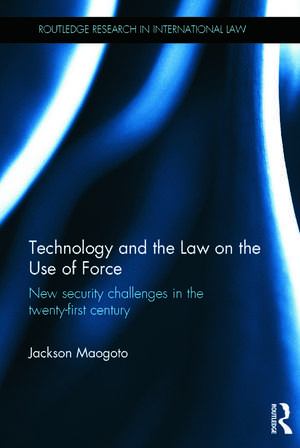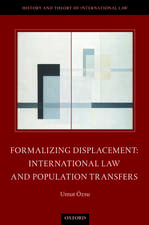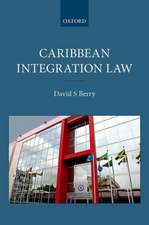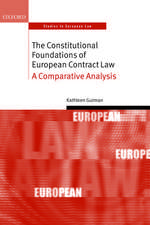Technology and the Law on the Use of Force: New Security Challenges in the Twenty-First Century: Routledge Research in International Law
Autor Jackson Maogotoen Limba Engleză Hardback – 24 noi 2014
This book takes a detailed look at these new theatres of war and considers their relation to international law on the use of force. Except in cases of self-defence or with the authorisation of a Security Council Resolution, the use of force is prohibited under the UN charter and customary international law. However, the law of jus ad bellum was developed in a pre-digital era where current technological capabilities could not be conceived. Jackson Maogoto asks whether the law on the use of force is able to deal with legal disputes likely to arise from modern warfare. Key queries include how one defines an armed attack in an age of anti-satellite weaponry, whether the destruction of a State’s vital digital eco-system or the "blinding" of military communication satellites constitutes a threat, and how one delimits the threshold that would enliven the right of self-defence or retaliatory action. The book argues that while technology has leapt ahead, the legal framework has failed to adapt, rendering States unable to legally defend themselves effectively.
The book will be of great interest and use to researchers and students of international law, the law of armed conflict, Information Technology and the law, and counter-terrorism.
| Toate formatele și edițiile | Preț | Express |
|---|---|---|
| Paperback (1) | 489.26 lei 43-57 zile | |
| Taylor & Francis – 8 noi 2016 | 489.26 lei 43-57 zile | |
| Hardback (1) | 1050.78 lei 43-57 zile | |
| Taylor & Francis – 24 noi 2014 | 1050.78 lei 43-57 zile |
Din seria Routledge Research in International Law
-
 Preț: 296.42 lei
Preț: 296.42 lei -
 Preț: 151.71 lei
Preț: 151.71 lei -
 Preț: 311.94 lei
Preț: 311.94 lei -
 Preț: 311.70 lei
Preț: 311.70 lei - 8%
 Preț: 375.14 lei
Preț: 375.14 lei -
 Preț: 281.27 lei
Preț: 281.27 lei - 18%
 Preț: 1053.16 lei
Preț: 1053.16 lei -
 Preț: 484.47 lei
Preț: 484.47 lei -
 Preț: 282.62 lei
Preț: 282.62 lei -
 Preț: 410.46 lei
Preț: 410.46 lei - 18%
 Preț: 1054.75 lei
Preț: 1054.75 lei - 18%
 Preț: 727.38 lei
Preț: 727.38 lei -
 Preț: 422.04 lei
Preț: 422.04 lei - 18%
 Preț: 1054.71 lei
Preț: 1054.71 lei - 18%
 Preț: 1074.44 lei
Preț: 1074.44 lei - 18%
 Preț: 1059.48 lei
Preț: 1059.48 lei - 18%
 Preț: 1060.52 lei
Preț: 1060.52 lei - 18%
 Preț: 1058.43 lei
Preț: 1058.43 lei -
 Preț: 452.27 lei
Preț: 452.27 lei -
 Preț: 451.41 lei
Preț: 451.41 lei -
 Preț: 419.11 lei
Preț: 419.11 lei - 28%
 Preț: 822.34 lei
Preț: 822.34 lei -
 Preț: 494.07 lei
Preț: 494.07 lei - 18%
 Preț: 1118.46 lei
Preț: 1118.46 lei -
 Preț: 491.60 lei
Preț: 491.60 lei -
 Preț: 490.25 lei
Preț: 490.25 lei - 18%
 Preț: 1178.15 lei
Preț: 1178.15 lei -
 Preț: 444.62 lei
Preț: 444.62 lei -
 Preț: 454.22 lei
Preț: 454.22 lei - 14%
 Preț: 301.05 lei
Preț: 301.05 lei -
 Preț: 419.32 lei
Preț: 419.32 lei - 18%
 Preț: 1052.38 lei
Preț: 1052.38 lei - 18%
 Preț: 1111.87 lei
Preț: 1111.87 lei - 18%
 Preț: 1112.34 lei
Preț: 1112.34 lei - 15%
 Preț: 550.99 lei
Preț: 550.99 lei - 18%
 Preț: 1054.71 lei
Preț: 1054.71 lei -
 Preț: 422.91 lei
Preț: 422.91 lei -
 Preț: 286.51 lei
Preț: 286.51 lei - 18%
 Preț: 1117.88 lei
Preț: 1117.88 lei
Preț: 1050.78 lei
Preț vechi: 1281.44 lei
-18% Nou
Puncte Express: 1576
Preț estimativ în valută:
201.06€ • 210.49$ • 166.37£
201.06€ • 210.49$ • 166.37£
Carte tipărită la comandă
Livrare economică 07-21 aprilie
Preluare comenzi: 021 569.72.76
Specificații
ISBN-13: 9780415694339
ISBN-10: 0415694337
Pagini: 130
Ilustrații: black & white illustrations
Dimensiuni: 156 x 234 x 13 mm
Greutate: 0.34 kg
Ediția:1
Editura: Taylor & Francis
Colecția Routledge
Seria Routledge Research in International Law
Locul publicării:Oxford, United Kingdom
ISBN-10: 0415694337
Pagini: 130
Ilustrații: black & white illustrations
Dimensiuni: 156 x 234 x 13 mm
Greutate: 0.34 kg
Ediția:1
Editura: Taylor & Francis
Colecția Routledge
Seria Routledge Research in International Law
Locul publicării:Oxford, United Kingdom
Public țintă
PostgraduateCuprins
Introduction 1. Use of Force: Displaced 20th Century Rules, Norms and Standards? 2. Revolution in Military Affairs: Hi-Tech Weaponry, Low-Tech Legal Safeguards 3. The Fourth Domain—Ascendance of Space as a War Theatre 4. The Fourth Domain—Ascendance of Space as a War Theatre 5. Discarding Law by Analogy—Old Legal Frameworks for New Threats Conclusion
Descriere
This book takes a detailed look at attacks of government information infrastructure and considers their relation to international law on the use of force. Except in cases of self-defence or with the authorisation of a Security Council Resolution, the use of force is prohibited under the UN charter and customary international law. However, the law of jus ad bellum was developed in a pre-digital era where current technological capabilities could not be conceived. Jackson Maogoto asks whether the law on the use of force is able to deal with legal disputes likely to arise from modern warfare.
















